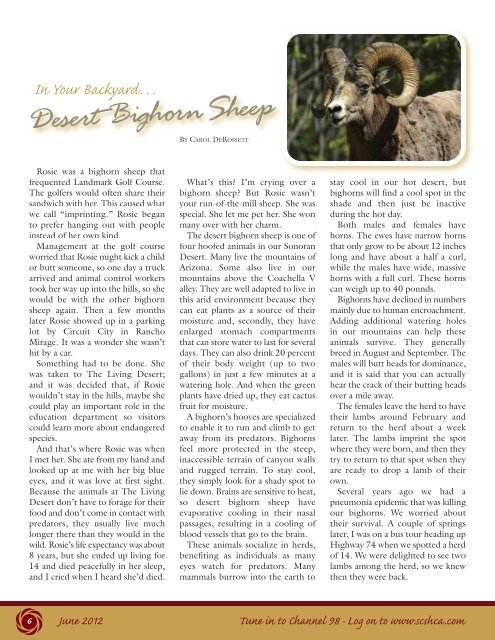June 2012 scshview_2012-06.pdf - Sun City Shadow Hills
June 2012 scshview_2012-06.pdf - Sun City Shadow Hills
June 2012 scshview_2012-06.pdf - Sun City Shadow Hills
Create successful ePaper yourself
Turn your PDF publications into a flip-book with our unique Google optimized e-Paper software.
6<br />
In Your Backyard…<br />
Desert Bighorn Sheep<br />
Rosie was a bighorn sheep that<br />
frequented Landmark Golf Course.<br />
The golfers would often share their<br />
sandwich with her. This caused what<br />
we call “imprinting.” Rosie began<br />
to prefer hanging out with people<br />
instead of her own kind.<br />
Management at the golf course<br />
worried that Rosie might kick a child<br />
or butt someone, so one day a truck<br />
arrived and animal control workers<br />
took her way up into the hills, so she<br />
would be with the other bighorn<br />
sheep again. Then a few months<br />
later Rosie showed up in a parking<br />
lot by Circuit <strong>City</strong> in Rancho<br />
Mirage. It was a wonder she wasn’t<br />
hit by a car.<br />
Something had to be done. She<br />
was taken to The Living Desert;<br />
and it was decided that, if Rosie<br />
wouldn’t stay in the hills, maybe she<br />
could play an important role in the<br />
education department so visitors<br />
could learn more about endangered<br />
species.<br />
And that’s where Rosie was when<br />
I met her. She ate from my hand and<br />
looked up at me with her big blue<br />
eyes, and it was love at first sight.<br />
Because the animals at The Living<br />
Desert don’t have to forage for their<br />
food and don’t come in contact with<br />
predators, they usually live much<br />
longer there than they would in the<br />
wild. Rosie’s life expectancy was about<br />
8 years, but she ended up living for<br />
14 and died peacefully in her sleep,<br />
and I cried when I heard she’d died.<br />
BY CAROL DEROSSETT<br />
What’s this? I’m crying over a<br />
bighorn sheep? But Rosie wasn’t<br />
your run-of-the-mill sheep. She was<br />
special. She let me pet her. She won<br />
many over with her charm.<br />
The desert bighorn sheep is one of<br />
four hoofed animals in our Sonoran<br />
Desert. Many live the mountains of<br />
Arizona. Some also live in our<br />
mountains above the Coachella V<br />
alley. They are well adapted to live in<br />
this arid environment because they<br />
can eat plants as a source of their<br />
moisture and, secondly, they have<br />
enlarged stomach compartments<br />
that can store water to last for several<br />
days. They can also drink 20 percent<br />
of their body weight (up to two<br />
gallons) in just a few minutes at a<br />
watering hole. And when the green<br />
plants have dried up, they eat cactus<br />
fruit for moisture.<br />
A bighorn’s hooves are specialized<br />
to enable it to run and climb to get<br />
away from its predators. Bighorns<br />
feel more protected in the steep,<br />
inaccessible terrain of canyon walls<br />
and rugged terrain. To stay cool,<br />
they simply look for a shady spot to<br />
lie down. Brains are sensitive to heat,<br />
so desert bighorn sheep have<br />
evaporative cooling in their nasal<br />
passages, resulting in a cooling of<br />
blood vessels that go to the brain.<br />
These animals socialize in herds,<br />
benefiting as individuals as many<br />
eyes watch for predators. Many<br />
mammals burrow into the earth to<br />
stay cool in our hot desert, but<br />
bighorns will find a cool spot in the<br />
shade and then just be inactive<br />
during the hot day.<br />
Both males and females have<br />
horns. The ewes have narrow horns<br />
that only grow to be about 12 inches<br />
long and have about a half a curl,<br />
while the males have wide, massive<br />
horns with a full curl. These horns<br />
can weigh up to 40 pounds.<br />
Bighorns have declined in numbers<br />
mainly due to human encroachment.<br />
Adding additional watering holes<br />
in our mountains can help these<br />
animals survive. They generally<br />
breed in August and September. The<br />
males will butt heads for dominance,<br />
and it is said that you can actually<br />
hear the crack of their butting heads<br />
over a mile away.<br />
The females leave the herd to have<br />
their lambs around February and<br />
return to the herd about a week<br />
later. The lambs imprint the spot<br />
where they were born, and then they<br />
try to return to that spot when they<br />
are ready to drop a lamb of their<br />
own.<br />
Several years ago we had a<br />
pneumonia epidemic that was killing<br />
our bighorns. We worried about<br />
their survival. A couple of springs<br />
later, I was on a bus tour heading up<br />
Highway 74 when we spotted a herd<br />
of 14. We were delighted to see two<br />
lambs among the herd, so we knew<br />
then they were back.<br />
<strong>June</strong> <strong>2012</strong> Tune in to Channel 98 · Log on to www.scshca.com




